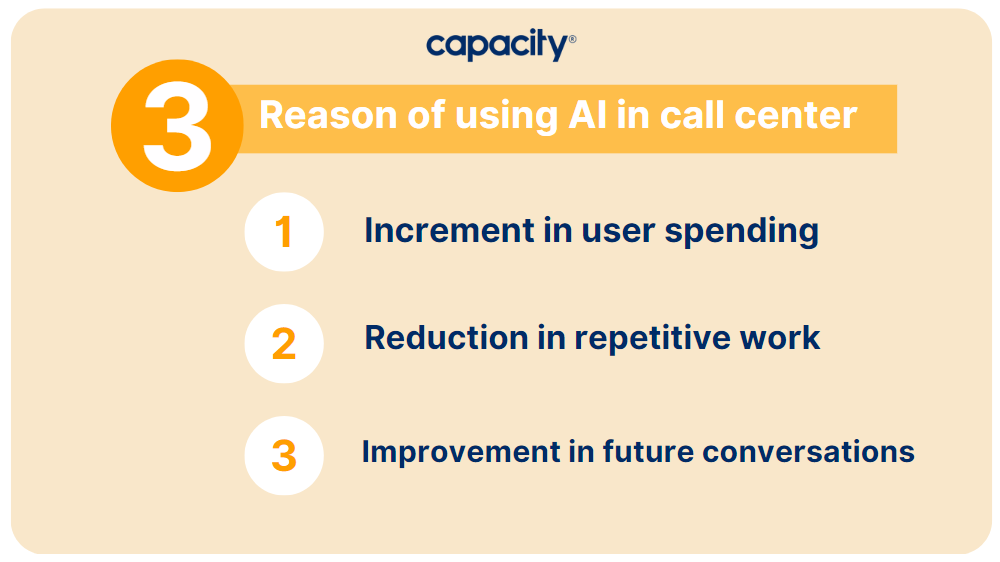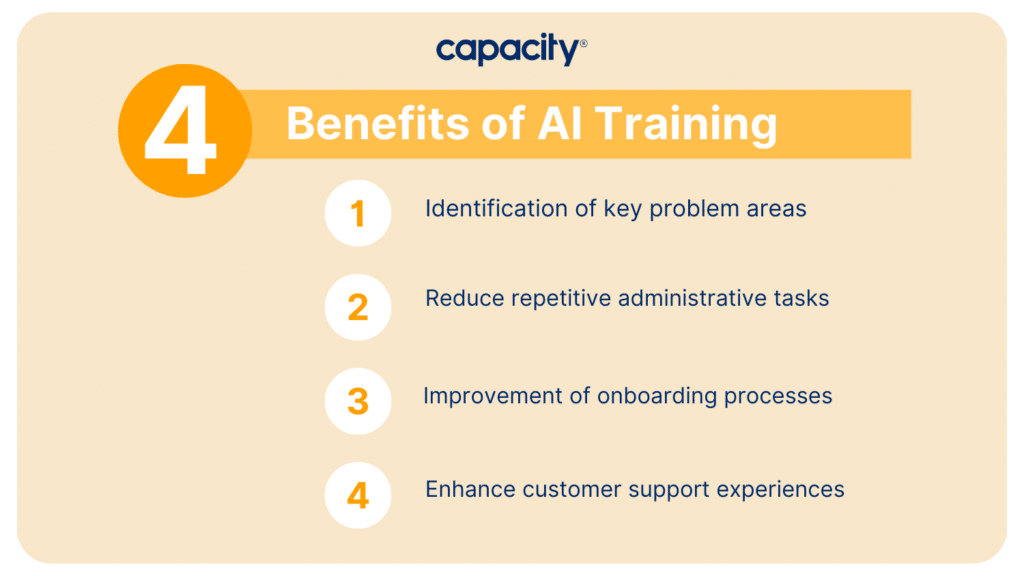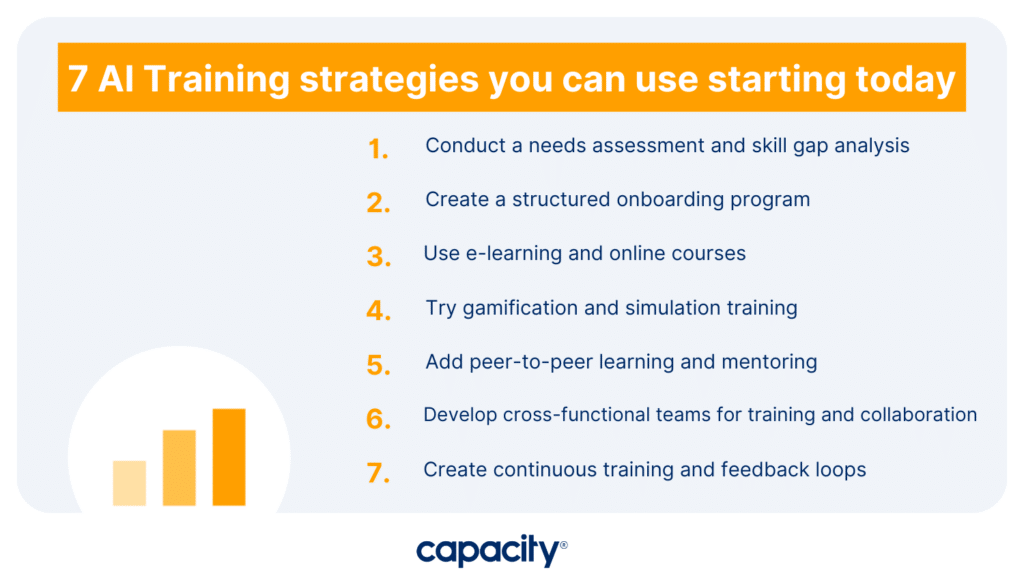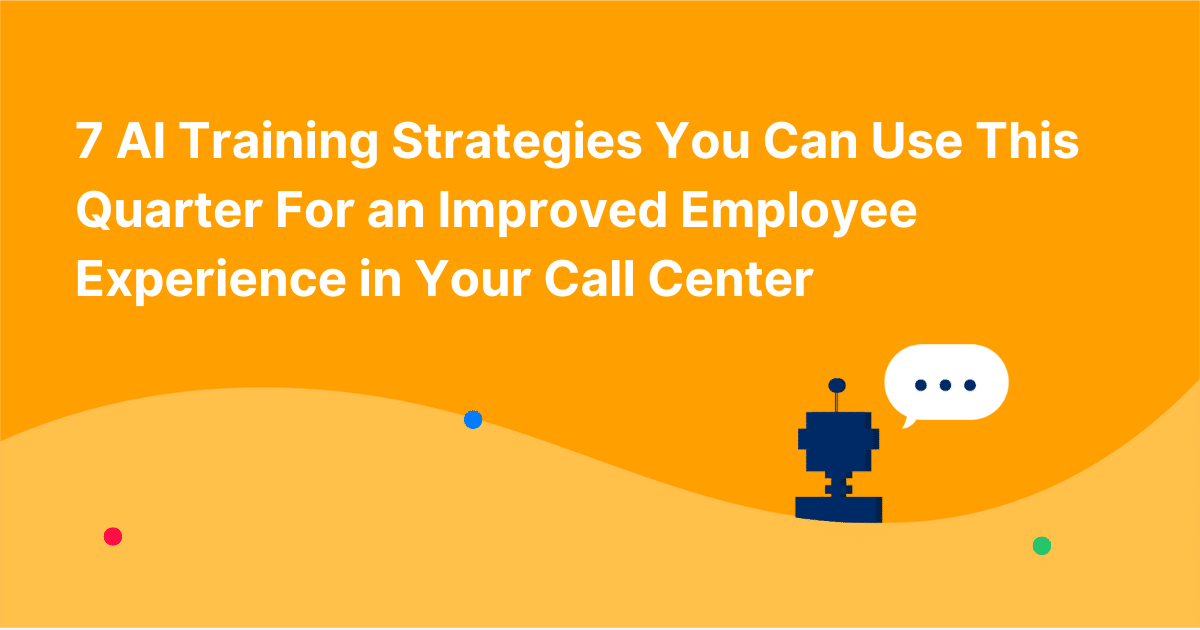As customer representative teams start to embrace AI technology, it’s important for organizations to ensure their employees are properly trained on the new tools and understand how using them can improve customers’ experiences. Companies must invest in training strategies that include the use of AI. Especially now when 75% of customers say they spend more money when interacting with AI-based technologies. As a contact center manager or IT professional, understanding these seven effective training strategies is essential for the successful deployment and integration of your organization’s artificial intelligence tech this quarter. Read on as we take you through each strategy and provide guidance on where to get started so you can upskill your team quickly, effectively, and confidently.
Why you should use AI in your call center
AI has revolutionized the way businesses interact with their customers, and call centers are no exception. With the ability to communicate on a mass scale and decrease wait times, conversational AI-powered call centers are quickly becoming the norm. This technology not only cuts losses but also drives revenue by fostering stronger relationships with an expanded network of customers. As call centers become increasingly familiarized with conversational AI-powered technology, they will start exploring new ways to use it in marketing and sales practices, such as providing tailored product recommendations and in-messaging purchases.
Brands that offer messages powered by AI have seen increased consumer spending, and call center agents can focus on more complex issues as automation takes care of repetitive tasks. With AI training, brands can even analyze performance metrics and benchmarks to further improve future conversations.

A few benefits of AI Training
The benefits of AI training are numerous for improving customer support experiences. AI can aid call center leaders in analyzing customer sentiments, and agent performance and identifying key problem areas. Additionally, it can take over repetitive administrative tasks, freeing agents to focus on resolving customer challenges. With its ability to analyze hours of voice data, AI can identify performance patterns among representatives, allowing managers to develop top performers faster. By leveraging insights from AI and their teams, customer support leaders can improve onboarding processes and provide tailored training to fill any gaps in performance. AI training is a game-changer for call centers looking to reduce operational overhead while enhancing customer support experiences.

7 AI Training strategies you can use starting today
To stay competitive in the ever-evolving business landscape, AI training has become essential for organizations of all sizes. But where do you begin? Luckily, there are seven effective strategies that you can implement starting today. Start off by conducting a thorough needs assessment and skill gap analysis to determine what areas need improvement. Next, create a structured onboarding program to ensure that all employees are properly trained. Supplement this with e-learning and online courses, as well as gamification and simulation training to keep employees engaged and motivated.
Don’t forget to incorporate peer-to-peer learning and mentoring to create a collaborative environment. Developing cross-functional teams can also boost collaboration and provide diverse perspectives. Lastly, embrace continuous training and feedback loops to keep up with the ever-changing industry. With these strategies in place, your organization will be well-equipped to train employees in AI and stay ahead of the game.

Strategy 1: Conduct a needs assessment and skill gap analysis
Artificial intelligence (AI) has revolutionized the way we work and interact with technology. As more companies adopt AI, there is a growing demand for employees who can develop, maintain, and operate these systems. However, it’s important to ensure that your workforce has the necessary skills before embarking on AI training. That’s where conducting a needs assessment and skill gap analysis comes in. By taking a close look at your current workforce,
you can identify the skills gaps and the training needs required to fill them. This strategy will not only help you achieve your AI goals but also ensure that your employees are equipped with the skills they need to succeed in the digital economy.
Strategy 2: Create a structured onboarding program
In today’s fast-paced business environment, a structured onboarding program is essential to ensure that new employees are able to hit the ground running. And with the rise of Artificial Intelligence (AI) in the workplace, it’s more important than ever to provide adequate training for new hires. By implementing a comprehensive onboarding process that includes AI training, businesses can set their new employees up for success from day one. This approach not only helps to increase productivity and reduce turnover, but it also demonstrates a commitment to investing in the long-term success of the company. So if you want to stay ahead in today’s competitive market, creating a structured onboarding program that prioritizes AI training is a must.
Strategy 3: Use e-learning and online courses
As technology continues to advance, more and more industries are turning to e-learning and online courses to educate and train their workforce. In particular, AI training has become an increasingly crucial area of focus for companies looking to stay ahead of the curve. Online courses offer flexible learning options that can be tailored to fit individual schedules and needs, while e-learning platforms can provide interactive and engaging opportunities for hands-on practice and skill-building. Investing in AI training through e-learning and online courses not only helps businesses maintain their competitive edge but also ensures that employees are equipped with the skills they need to thrive in an increasingly tech-driven world.
Strategy 4: Try gamification and simulation training
Staying ahead of the curve is critical to success. One way to do this is by leveraging gamification and simulation training to boost your team’s AI training. These immersive techniques allow employees to engage in realistic scenarios and learn by doing. By incorporating play elements into the training process, your team will be more motivated and enjoy increased retention rates. Plus, simulation training can help identify knowledge gaps and provide real-time feedback, allowing your team to improve their skills faster. If you’re serious about building a competitive advantage, consider incorporating gamification and simulation training into your training strategy.
Strategy 5: Add peer-to-peer learning and mentoring
To effectively train employees in the ever-growing field of AI, companies should consider
implementing peer-to-peer learning and mentoring strategies. By allowing employees to learn from their peers and receive guidance from experienced mentors, they will develop a deeper understanding of the subject matter and feel more confident in their abilities. Peer-to-peer learning can also foster a sense of camaraderie and collaboration among colleagues. As a result, companies can expect an increase in employee engagement and overall productivity. Investing in the development of AI skills through peer-to-peer learning and mentoring is a wise strategy for companies looking to stay ahead in today’s competitive marketplace.
Strategy 6: Develop cross-functional teams for training and collaboration
It’s incredibly important for companies to have effective strategies for developing their teams. One such strategy that has been gaining traction in recent years is the use of cross-functional teams for training and collaboration. By bringing together individuals from different areas of expertise, these teams can combine their knowledge and skills to solve complex problems and achieve business goals. And when it comes to emerging technologies like AI, cross-functional teams can play a particularly critical role in driving success. By having individuals with a range of skills and perspectives working together, companies can ensure that their AI training efforts are comprehensive, effective, and tailored to their particular needs.
Strategy 7: Create continuous training and feedback loops
Creating continuous training and feedback loops is a crucial aspect of any successful business strategy. With the rapid advancements in technology, it is essential to stay updated with the latest techniques and tools. This is where artificial intelligence (AI) training comes in. AI has fast become an integral part of many businesses, and staying ahead of the curve means investing in employee training and development. By creating continuous training programs and feedback loops, employees can stay up-to-date on the latest AI technology, ensuring their skills remain relevant and valuable to the company. Not only does this improve productivity and efficiency, but it also fosters a culture of innovation and growth.
Implementing AI training strategies can bring potential benefits and improved customer service to any call center. From conducting skill assessments to creating an onboarding plan, using e-learning, gamification, and simulations, peer learning and mentoring, cross-functional teams for collaboration, and continuous training and feedback loops – these 7 AI Training Strategies can help get your team up and running faster. Incorporating AI into your call center with thoughtful planning can make a huge difference in employee productivity, customer engagement, satisfaction & loyalty. Don’t miss this extraordinary opportunity to unlock the full potential of your team’s skills through AI. Make the most of it with Capacity. Try Capacity for free now, so you can start taking advantage of the best in AI-driven customer service!

Automate Your Work
Capacity’s enterprise AI chatbot can help:
- Answer FAQs anytime, anywhere
- Find relevant documents within seconds
- Give surveys and collect feedback














































